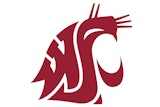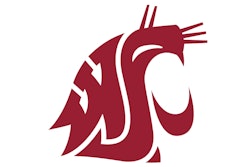![[Photo courtesy of John Deere]](https://img.athleticbusiness.com/files/base/abmedia/all/image/2019/07/ab.fleet719_feat.png?auto=format%2Ccompress&q=70&w=400)
They can provide a smooth finish on a baseball infield and a smooth lift for an injured football player. They can haul fertilizer and tow the spreader that will throw it. They can transport mechanics and mechanical supplies within the bowels of a stadium and shuttle fans from parking areas to turnstiles on game day or recruits across campus during tour visits. Few pieces of equipment have as far reaching an impact on facility operations as the utility vehicle.
These highly customizable four-wheeled carts go where heavier vehicles don't dare tread — on pristine natural grass or synthetic turf — and they can weave in and around human and inanimate objects with relative ease.
"They're very maneuverable, whether it's a practice field or the sidelines," says Brooks Hastings, project manager at John Deere, manufacturer of Gator™ brand utility vehicles. "When you're watching either practices or games at the collegiate or professional level, a lot of times you'll see one or two Gators staged on the sideline. One can have a med bed — basically a platform on it for an injured individual — and the other has just the regular cargo bed on it."
But options don't stop there. Here are a few things to consider when outfitting your fleet.
Where to?
Many utility vehicles traversing an athletics campus are classified by the National Highway Traffic Safety Administration as low-speed vehicles, or LSVs, meaning their top speed doesn't exceed 25 miles per hour and their overall weight including passengers and cargo doesn't exceed 3,000 pounds. However, even these utility vehicles can be considered street legal when operated in traffic areas with low speed limits and if they bear a legally procured license plate.
"Our on-road vehicles come with automotive brakes, tires, glass, turn signals, seat belts, all forward-facing seats," says Tate Johnson, business director for Global Electric Motorcars at Polaris, which manufacturers two models of utility cart, as well as three models of shuttle — none of which run on gas. "You can get a license plate for our vehicles. To go on public roads, our vehicles need to be registered and in order to register them you have to certify that it's going to be driven by someone with a driver's license. If you're on a closed campus, or your own private property, you can do with that what you choose to do, but our recommendation for the driver is at least 16 years of age and appropriately trained and licensed."
John Deere manufactures several gas- or diesel-powered crossover utility vehicles with top speeds exceeding 30 and 40 mph, depending on the model and the fuel it runs on. One so-called high-performance model can reach 60 mph while still hauling 500 pounds of cargo or towing up to 1,200 pounds. However, Hastings says these machines are designed for farm use primarily, and though applicable to an athletic department fleet, they could be "overkill." The company's traditional utility vehicles, equipped with turf-friendly tires, top out at 25 mph.
![You think that you know what you want to use it for, but it turns out you can use it for so much more. [Photo courtesy of John Deere]](https://img.athleticbusiness.com/files/base/abmedia/all/image/2019/07/ab.fleet719a.png?auto=format%2Ccompress&fit=max&q=70&w=400) You think that you know what you want to use it for, but it turns out you can use it for so much more. [Photo courtesy of John Deere]
You think that you know what you want to use it for, but it turns out you can use it for so much more. [Photo courtesy of John Deere]
Gas or electric?
One of the first choices an end-user can make when specifying a utility vehicle is its power source. Every major manufacturer now offers at least one electric utility vehicle.
"I think about our athletics customer base, especially in the college setting, and sustainability — being green — is a prominent theme that they want to convey," Johnson says. "Not only that, but the thing that we see people going electric for is the noise — there's no noise pollution. Whether you're an athlete on the sideline or you're a fan, there's no distraction from the noise. That's one of the reasons that athletics have kind of morphed into electric more. But certainly if you run around youth athletic fields, you might even see an old Polaris gas vehicle pulling around the screen behind it on the infield."
"It all depends on the client. Some are just used to gas units, and they want gas. They may not have anything electric in the fleet and they don't want to mix and match," Hastings says. "There are some that are driven by noise requirements, and they go with the electric."
Electric vehicles carry a higher upfront price — by several thousand dollars, typically — compared to a gas-powered counterpart with the same chassis and features. And while an electric utility vehicle can work all day, just like a gas-powered machine, it may not be able to work quite as hard, according to Hastings. The traditional gas-powered Gator can tow 900 pounds compared to 500 for the electric Gator, which has less than half the horsepower. "Obviously it depends on how it's loaded," Hastings says. "If it's overloaded, it's not going to go all day, but we have it to where they can use it for the same amount of time during the working day as a gas unit, and then plug it in at night to charge."
Charging times will depend on both the charging equipment — Polaris GEMs come with a 1 kilowatt charger that plugs into a standard outlet — and the battery type. "I'll talk about lithium ions, because that's the biggest battery pack we offer," says Johnson. "That battery pack is 12.4 kilowatts, so if it were completely dead and you just used the charger from the factory — no upgraded charger — it will take you about 12 hours to charge it."
The company also offers 3 kW and 6 kW chargers that will restore full power to the vehicle much faster. "That 3 kW charger — from dead, and very infrequently do you ever let your batteries get that low — would take you four hours to do that 12 kW pack," Johnson says. "And if you put the 6 kW charger on, you could do it in two hours. You're decreasing your charger time by a factor of six."
What's the financial draw of all that electricity? According to Polaris, cost of ownership of one of its electric vehicles is approximately $0.03 per mile. "As I think of some of the conversations I've had — whether it's with Major League Baseball, NFL or NHL franchises — a lot of what we're hearing and seeing is there is a push to be way more sustainable," Johnson says, adding that indoor arena settings, in particular, tend to eschew combustion engines and their resulting emissions. "Electric vehicles are very much in vogue with athletic departments and these outward-facing organizations. It's been a really cool partnership, whether it's a college or university or a major league franchise. It's been pretty impressive to watch."
![Our vehicles are very much tools. People are using them to get their job done. [Photo courtesy of Polaris]](https://img.athleticbusiness.com/files/base/abmedia/all/image/2019/07/ab.fleet719b.png?auto=format%2Ccompress&fit=max&q=70&w=400) Our vehicles are very much tools. People are using them to get their job done. [Photo courtesy of Polaris]
Our vehicles are very much tools. People are using them to get their job done. [Photo courtesy of Polaris]
Just how much utility?
To some extent, utility vehicles are designed based on the role they will ultimately fill within the fleet. This is especially true of passenger carts, which can seat up to six people.
However, most vehicles earmarked for field use can be highly customized.
"Our vehicles are very much tools," Johnson says. "People are using them to get their job done, and the way we've structured our business is we're made-to-order, so you can get the tool you need to do the job you have. You can get it with a ladder rack on it. You can get it with a number of different toolboxes. You can get it with a tailgate that folds down, so you can use a hand truck and easily move a washing machine or a dryer into it. You can get it with hard doors, without hard doors, with heat, without heat. You can get it with beacon lights or strobe lights. There are thousands of possible permutations of what different folks — from the electrician in a stadium to the emergency response person — might need."
As for the size of the fleet itself, Johnson says it wouldn't be out of the ordinary for a major college campus to employ "hundreds" of utility vehicles, with the athletic department's own fleet numbering in the "dozens." "In the past couple months, I've been on several college campuses — SEC schools — and met with some of their athletic departments, and they're talking about buying in excess of 20 vehicles in one shot," he says.
With that kind of commitment, buyer's remorse is not an option. "The interesting thing, if you're buying something like this, is that you think you know what you want to use it for, but it turns out you can use it for so much more once you get one, just because they're so maneuverable and versatile," says Hastings. "You could hook up a spreader, have a drag on it, a pull-behind aerifier. There are just a lot of things that you can use it for."
This article originally appeared in the July | August 2019 issue of Athletic Business with the title "Utility vehicles pulling their weight in facility operations." Athletic Business is a free magazine for professionals in the athletic, fitness and recreation industry. Click here to subscribe.





































